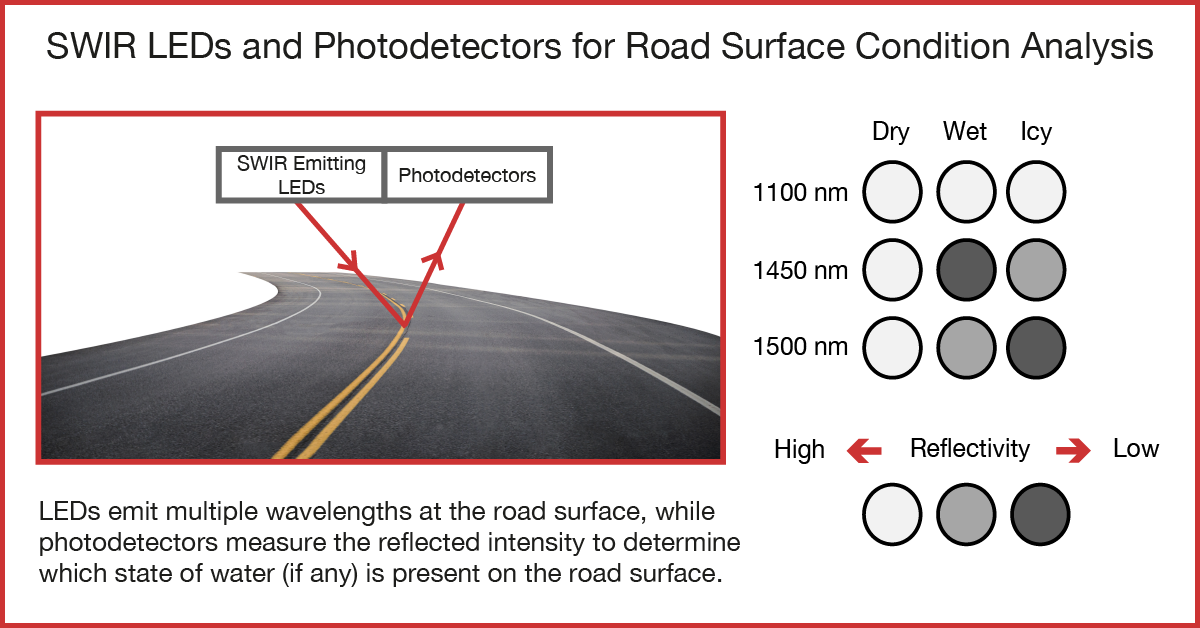Even the most competent drivers are subject to an increased risk of aquaplaning in wet conditions and landing an airplane on an icy runway potentially puts hundreds of lives in danger. The root cause of many accidents is unexpected, increased surface friction. The science of meteorology allows people to make accurate, though not entirely fool-proof, weather predictions. This often gives us a head start when planning a day at the beach and tips us off when it is time to seek shelter or wrap up in warm clothes.
SWIR LEDs have a unique ability to detect the different states of water through the difference in absorption ratio between 1400 nm and 1600 nm. Since ice absorbs more SWIR radiation than water, road surface condition systems can perceive conditions that are difficult to detect visually, such as black or clear ice.
When the resulting data is fed into analytical software, it is even possible to predict the potential risk of skidding and aquaplaning; however, from a general maintenance stand-point, these systems can trigger municipal “Smart City” protocols governing the dispatch of salt spreaders, de-icing, and effective traffic management.

How are Ushio’s SWIR LEDs used in road surface condition sensing?
Multiple SWIR wavelengths are emitted at the road by LEDs, with the reflective intensity of each wavelength measured by photodetectors. The photodetectors can be integrated into the same Ushio Epitex package as the LEDs or positioned nearby in their own package. The most important wavelengths in this application fall within the absorption bands of water and ice, such as 1450 nm and 1500 nm.
Both 1450 nm and 1500 nm are absorbed by liquid water, but 1450 nm has a greater absorption level. In the case of ice, however, both 1450 nm and 1500 nm are absorbed, but this time, more of the 1500 nm wavelength is absorbed. Based on the relationship between the strength of the absorption, it is determined whether the target is water or ice.
A third wavelength, neither absorbed by water or ice (e.g. 1100 nm), is required to serve as a reference point for the amount of light reflected from the road itself.
The relative intensity of the reflected light is used to accurately determine the condition of the road surface. To measure the intensity of each wavelength, multiple Ushio Epitex photodetectors are fitted with wavelength-specific band-pass filters.
Alternatively, a single photodetector can do the job, but only if each wavelength is emitted sequentially, rather than simultaneously. The timing of the lighting sequence can then be used to identify which wavelength is being reflected in each sensor image.
Once the data has been successfully captured, an algorithm is used to process the received information, with the end goal of determining the road surface condition.
Contact Ushio about road surface condition sensing solutions
If you would like to make an inquiry regarding the suitability of Ushio’s SWIR LEDs for your road surface condition sensing applications, please contact Ushio’s regional experts via the following link:
Don’t get left behind!
Looking to stay up-to-date with the latest breakthroughs, product releases, and features hitting the market? Join the SWIR-LED Club for FREE and get Ushio Epitex news deliver your mailbox.


